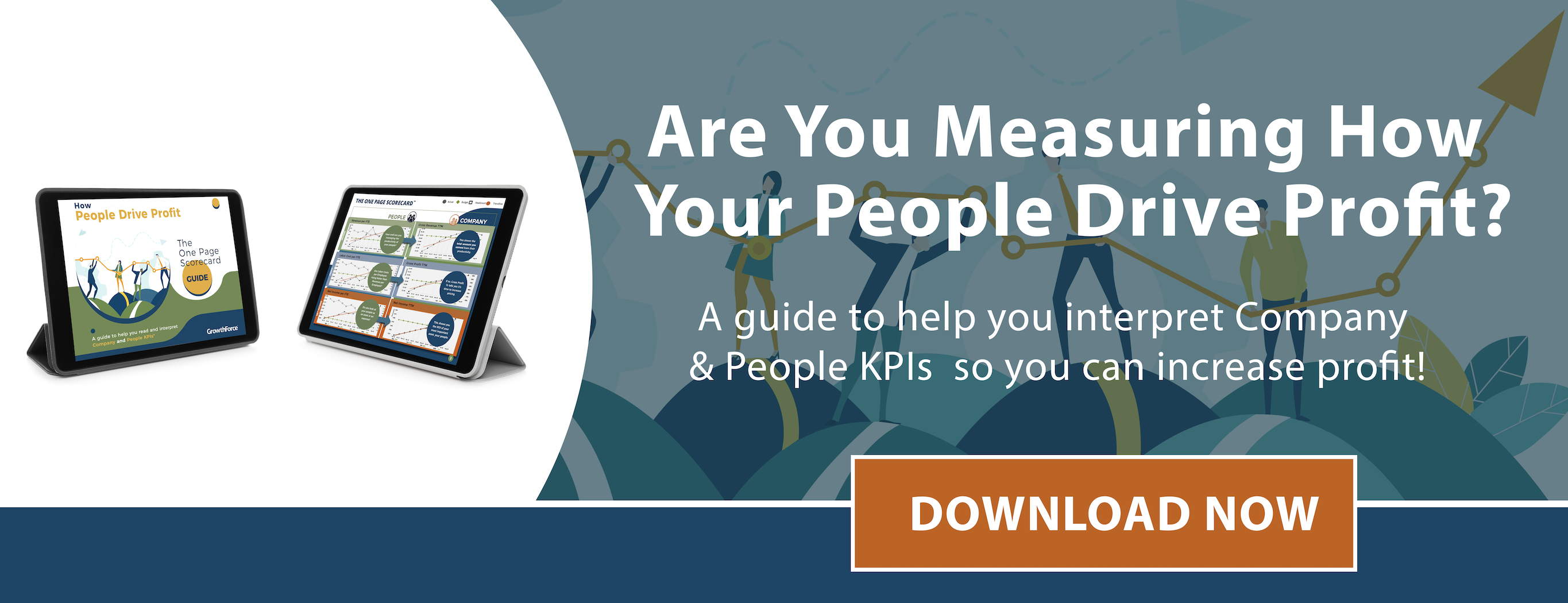6 min read

Business owners who view their employees as an expense rather than an asset- don't realize how much their people drive profit.
|
Key Takeaways
|
People are a business’s most valuable asset, and their efficient productivity, knowledge, expertise, and happiness are what drives profit. If you value them and have a human capital strategy that helps you appreciate and engage them, you’ll get a better return on investment.
Everyone in your organization needs to be set up for success. This means aligning people around a common vision, giving them concrete goals to achieve, and rewarding and recognizing their achievements.
7 Steps to Maximizing ROI on Employee Costs
1. Hire the Right People
You must first hire the right people because hiring the wrong people will lead to high rates of turnover and diminished employee morale which can be detrimental to and expensive for your company.
Look for individuals whose personalities align with your company culture, so you know they'll fit right in, get along well with others, and be team players from the start.
Sometimes, this first step is asking good questions to better understand their personality and values.
When you hire people who share your core values, you understand how they will contribute positively to your company with their behaviors, relationships, knowledge and expertise, and service.
If you invest in HR or a recruiter, having a human capital strategy and hiring great employees that want to stay will save money in turnover costs.
2. Align Everyone Around Common Goals
Have you thought about where you want your organization to be in one, three, or five years?
Although a lot can happen between now and then, and big-picture goals can change, you should still take the time to think about your company's future and set long-term goals. You can then work backward from your goals to see how each employee fits in their role.
Without a primary target, you'll find it difficult to create a business strategy, develop an operating framework, and rally your employees around a common purpose. Without long-term goals, you'll struggle when you try to determine what your short-term strategy should really be.
Employees with a clear line of sight and specific goals understand how their objectives directly affect their team, department, and the overall company goals.
Write it down. Written goals dramatically increase the chances of achieving those goals. According to a Harvard study [2] , setting goals and writing down your objectives increases your likelihood of success by 80%. Moreover, companies that had written goals showed a 700% increase in growth versus those that didn’t.
3. Provide Specific, Short-Term Benchmarks That Contribute to Company Success
Now that you've looked past the challenges you'll be facing in the upcoming quarter and have taken the time to consider the future of your organization, you can return to thinking about short-term goals on a monthly or quarterly basis.
Keeping your long-term goals in mind, take a look at your business at the department level to determine what each department and employee should be doing to move you closer to your lofty long-term goals. How can your whole company work as a team to execute your strategy and meet benchmarks that inch you closer and closer to the big picture?
This concept is called Cascading Goals: assigning smaller (but related) goals to departments, teams, and individuals that all contribute to achieving the overall operational goals.
Driving alignment between an organization's goals and employee's roles, Cascading goals are a crucial part of a lean business model and help ignite employee engagement and productivity.
Work with your department leaders to establish short-term goals for each department and employee to work toward. These goals should be specific, measurable, attainable, relevant, and timely (SMART) so that they provide a clear objective for your employees and cohesively move your company in the right direction.
4. Track Your Progress and Measure ROI
If you can't measure and track your progress, then you won't even know when your company and employees are moving in the right or wrong direction. While business leaders need to keep an eye on a variety of financial reports, trends, and key performance indicators (KPIs), there are some that can be used specifically to track the progress and ROI of your human capital strategy.
On your company's People Scorecard, you'll find a variety of charts and key performance indicators that will help you create policies, goals, and reward/compensation/recognition systems that actively engage your employees.
To measure your ROI on human capital, track the following KPIs:
- Revenue Per Hour Paid - Reveals the total revenue generated by your people. This can also reveal your cost of turnover and onboarding efficiency.
- Labor Cost Per Hour Paid - Reveals total labor costs, including "hidden" expenses.
- ROI on Total Labor Cost - Shows how much revenue labor costs generate.
Additionally, with the right accounting and time tracking systems in place, you can answer questions including:
- Net Income Per Employee - How healthy is the ratio of your people to your profits?
- Compensation Per Employee - Watch how this number shifts when you begin directly rewarding people for the profits they generate.
- Compensation as a % of Revenue - How much income does each $1 of salary generate? How do your compensation standards compare with others in the industry and are they in line with your organization's goals?
Over a longer period, you can observe trends in each of these metrics to determine whether your organization is moving in the right direction in terms of its people. Use the information to improve your human capital strategy and measure the quality of changes as they're implemented.
5. Reward and Recognize High-Performers
When your KPIs reveal exceptional performance and achievement from individuals in your company, never miss the opportunity to exercise positive reinforcement.
The best way to encourage high productivity is with a combination of monetary compensation or bonuses and public recognition among the employee's peers.
The numbers speak for themselves: a study from the Society of Human Resource Manager about workplace engagement found that companies with employee recognition programs and good career development guidance saw a 63 % increase in employee productivity and a 58% percent return on their profit margins. [3]
Implementing this kind of recognition and reward system as an integral component of your human capital strategy not only encourages high-performing employees to continue working hard but also motivates their peers to step up their efforts as well.
When your employees constantly feel motivated to increase their productivity and do the best they can during their billable hours, you'll see an uptick in your ROI (even if you spend a little more on bonuses).
6. Learn How to Strengthen Lower Performers (and Do It)
When you can identify the top performers in your company, you can also see who could be doing better. Take a look at exactly what your most productive employees do during the day. What's their process? What's their schedule like? What strategies do they use to meet their goals?
The impact will be seen on your bottom line. Research shows that on average, U.S. employees in small businesses waste more than 2 hours a day at work. That amounts to almost $700 billion per year in lost productivity! [1] Keeping them motivated and adding even as little as 15 minutes of productivity per day can add thousands of dollars to your profits.
With the model put forward by your top performers, you can transform your just-okay employees into good employees and your good employees into super-star employees. Then you can watch your ROI improve.
7. Adjust Goals and Repeat
When setting regular short-term goals and actively tracking employee performance, you'll be able to observe how your policies and human capital strategy affect trends in your financial management reports.
“Success is a moving target” - Mike Michalowicz (Small Business Author)
When you see things going in the right direction, ask yourself whether you can do better or if the positive trend is sustainable? Conversely, when you see your numbers trending in the wrong direction, take action right away.
Schedule regular leadership meetings with your department heads, so you can work together to reward productivity and solve problems before they have the opportunity to fester and turn into major obstacles.
Steps That Increase ROI on Human Capital Should Naturally Improve Employee Retention, Too
When you take active, intentional steps to improve ROI on human capital with a people-centric process, you'll find that the revolving door in your human resources department slows and your employee retention greatly improves, saving you loads in lost revenue and hiring costs. (Learn more about the cost of employee turnover.)
Consider what happens when employees:
- are provided a clear framework for achievement with attainable goals.
- are actively involved in contributing to the company's success.
- understand how they contribute by seeing the numbers.
- understand how they can improve and have opportunities to learn.
- feel recognized, fairly compensated, and rewarded for their efforts.
These employees feel valued and supported. They have a stake in the work they do. They feel fulfilled in their work. As a result, employees tend to stick around and businesses tend to become more and more successful.
[1] https://www.salary.com/chronicles/2014-wasting-time-at-work/
[2] https://www.wanderlustworker.com/the-harvard-mba-business-school-study-on-goal-setting/





